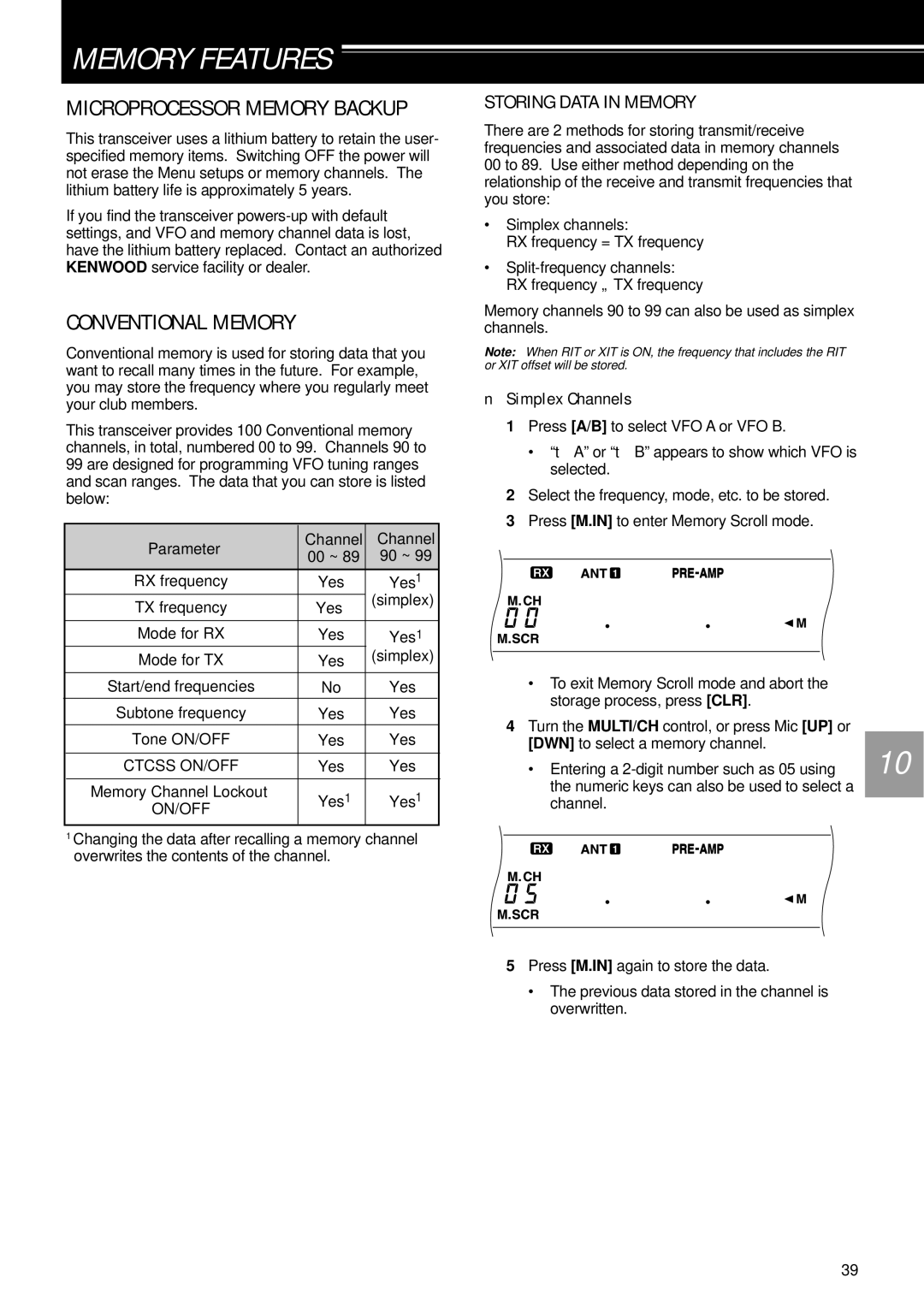
MEMORY FEATURES
MICROPROCESSOR MEMORY BACKUP | STORING DATA IN MEMORY | 1 | ||
There are 2 methods for storing transmit/receive | ||||
This transceiver uses a lithium battery to retain the user- |
| |||
frequencies and associated data in memory channels |
| |||
specified memory items. Switching OFF the power will |
| |||
00 to 89. Use either method depending on the |
| |||
not erase the Menu setups or memory channels. The | 2 | |||
relationship of the receive and transmit frequencies that | ||||
lithium battery life is approximately 5 years. | ||||
you store: | ||||
If you find the transceiver | ||||
|
|
| ||
• | Simplex channels: |
| ||
settings, and VFO and memory channel data is lost, |
| |||
| RX frequency = TX frequency |
| ||
have the lithium battery replaced. Contact an authorized |
| 3 | ||
|
| |||
KENWOOD service facility or dealer. | • | |||
RX frequency ≠ TX frequency
CONVENTIONAL MEMORY
Conventional memory is used for storing data that you want to recall many times in the future. For example, you may store the frequency where you regularly meet your club members.
This transceiver provides 100 Conventional memory channels, in total, numbered 00 to 99. Channels 90 to 99 are designed for programming VFO tuning ranges and scan ranges. The data that you can store is listed below:
Parameter | Channel |
| Channel | |
00 ~ 89 | 90 ~ 99 | |||
| ||||
RX frequency | Yes |
| Yes1 | |
|
|
| (simplex) | |
TX frequency | Yes | |||
|
| |||
|
|
|
| |
Mode for RX | Yes |
| Yes1 | |
Mode for TX | Yes |
| (simplex) | |
|
|
|
| |
Start/end frequencies | No |
| Yes | |
|
|
|
| |
Subtone frequency | Yes |
| Yes | |
|
|
|
| |
Tone ON/OFF | Yes |
| Yes | |
|
|
|
| |
CTCSS ON/OFF | Yes |
| Yes | |
|
|
|
| |
Memory Channel Lockout | Yes1 |
| Yes1 | |
ON/OFF |
| |||
|
|
| ||
|
|
|
| |
1Changing the data after recalling a memory channel overwrites the contents of the channel.
Memory channels 90 to 99 can also be used as simplex | 4 | |
channels. | ||
Note: When RIT or XIT is ON, the frequency that includes the RIT | ||
| ||
or XIT offset will be stored. |
| |
| ||
■ Simplex Channels | 5 | |
1 Press [A/B] to select VFO A or VFO B. | ||
| ||
|
|
•“tA” or “t B” appears to show which VFO is
selected.6
2Select the frequency, mode, etc. to be stored.
3Press [M.IN] to enter Memory Scroll mode.
7
8
• To exit Memory Scroll mode and abort the | 9 |
storage process, press [CLR]. |
4Turn the MULTI/CH control, or press Mic [UP] or [DWN] to select a memory channel.
• Entering a | 10 | ||
the numeric keys can also be used to select a |
| ||
channel. |
| ||
11 | |||
|
| ||
|
| ||
|
|
| |
|
|
| |
|
| 12 | |
|
|
| |
5 Press [M.IN] again to store the data. | 13 | ||
• The previous data stored in the channel is | |||
overwritten.
14
15
16
39
